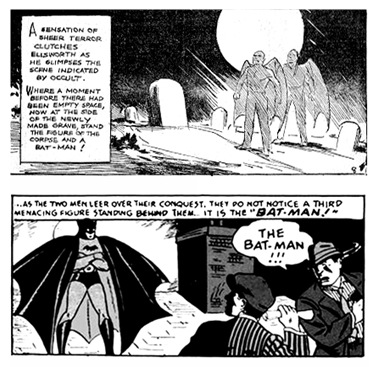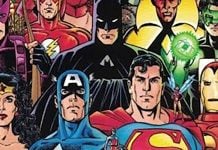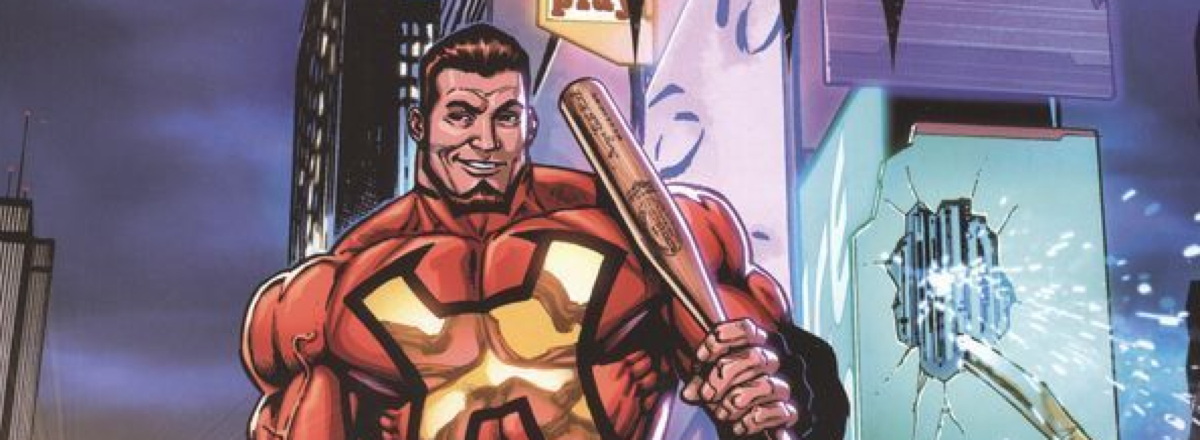All the references to Mark Millar’s infamous “Orson Welles was doing a Batman movie hoax” of 2003 in this piece by Brad Ricca suggest to me that this is another clever hoax: the claim that in the May 1937 issue of More Fun featuring Doctor Occult, the Siegel and Shuster team has drawn a familiarly shaped proto-Bat-man. The actual Batman first appeared in Detective Comics #27 (May 1939).
Although Superman was the most famous creation of the Siegel and Shuster team, it wasn’t their first work. They had already created Doctor Occult for More Fun in 1935. According to Ricca, author of the excellent biography of the Superman creators, Superboys, the timing lends itself to a host of theories:
The two panels have visual similarities, but here’s where it gets really interesting: two issues after the Doctor Occult story in More Fun, Kane himself began contributing to the magazine, meaning that he surely must have been familiar with Siegel and Shuster’s work. And the editor on More Fun in 1937 who gave Kane his first work there? None other than Vin Sullivan, the man who would then allegedly ask Kane to pitch a new superhero to him, just like one of Siegel and Shuster’s, barely two years later.
Ricca doesn’t draw any conclusions on why this was done or whether it was some kind of in joke. As I said, the frequent mentions of hoaxes, made me suspicious of this but in a tweet, Ricca says it’s not a hoax:
@Comixace No joke! And I don't have a Mr. T sweater, either. Here's the original. pic.twitter.com/6o8WQAwPfr
— BradRicca (@BradJRicca) October 1, 2013
That said, if it were it would be a pretty clever gag, laying as it does on comics scholars who study the publishing history of Major Malcolm Wheeler-Nicholson. And the truth is both Shuster and the swipe-happy Kane were drawing on familiar Dracula images. So this is almost certainly a case of swiping the same influence.
Still…interesting.









I know this will never happen because of the years of legal fighting between Warners and the families, but God, do I wish they’d put out a nice collection of all the early Siegel/Shuster comics. Yeah, they’re often rough around the edges, but stuff like Doctor Occult and Radio Squad have a certain verve to them that shows the energy and promise of that team’s imagination. It’s a shame you can only read that stuff by digging it up online.
This is one instance where Bob Kane may have actually been influenced, rather than swiping. The Batman’s cape is similar is design, but the Siegel/Shuster characters are rather nondescript in comparison.
It sure looks like Batman to me. Uht Oh someone has some explaining to do. But maybe we should keep quiet about this. Please no more legal issues; it’s not good for the fans.
but kane came up with SKYMAN and that charactor had a stiff glider wing style cape. it was bill finger who gave him his cowl and cape, and also changed the name to batman, so it would have to be finger swiping the panel.
Winged, cloaked, batlike figures had been around in “sensational” fiction for donkey’s years. No case to answer.
I think what everyone is missing here is that not only did Jerry and Joe present a bat-winged figure but that the text actually refers to “a bat-man.”
I’ve seen pages from that story before. It’s not a hoax. Also, too well-drawn to be a hoax. Given that Kane himself contributed to the magazine, I think the case is strong that the scene inspired his superhero “Bat-man” much in the way that Flash Gordon’s Hawkmen inspired, etc. Remember that Kane just put batwings on a standard-issue superhero suit before Finger added the headpiece.
The whole story here:
http://fourcolorshadows.blogspot.com/2012/11/dr-occult-siegel-and-shuster-1939-37.html
I agree with Booksteve — it’s the name and spelling that gets me. And a brief correction for my initial post — the More Fun issue in question is #28 from January 1938 — sorry for the typo (my fault). Note that this brings the appearance of Siegel and Shuster’s “Bat-man” a year closer to the Detective #27 “Bat-man.”
Hoax? Conspiracy? Or a reason to hunt down this issue?
An odd, or unfortunate, thing about the idea of Batman being swiped by someone is that, in genre fiction, influences aren’t concealed. They’re celebrated. Authors readily talk about their favorite authors; blurbs on the back of dust jackets compare _____ to _____ favorably. Authors don’t resist comparisons because they’re selling stories, not characters, and the details in their stories are what distinguish them from each other and make them enjoyable. If genre fiction authors considered characters their properties, and fought to prevent other authors from using similar characters in their stories, fictional genres wouldn’t exist.
SRS
So I’ve posted some more evidence (and maybe an answer) over at my blog:
http://brad-ricca.com/?p=3610
Superman was certainly a massive hodgepodge of cultural and character swipes and influence — and so was Batman — just a question of whether or not there was any intersection. The evidence is obviously flimsy at best (just one panel), but I wonder if there would have been a remote legal avenue here, in some past parallel universe? Jeff Trexler?
Comments are closed.